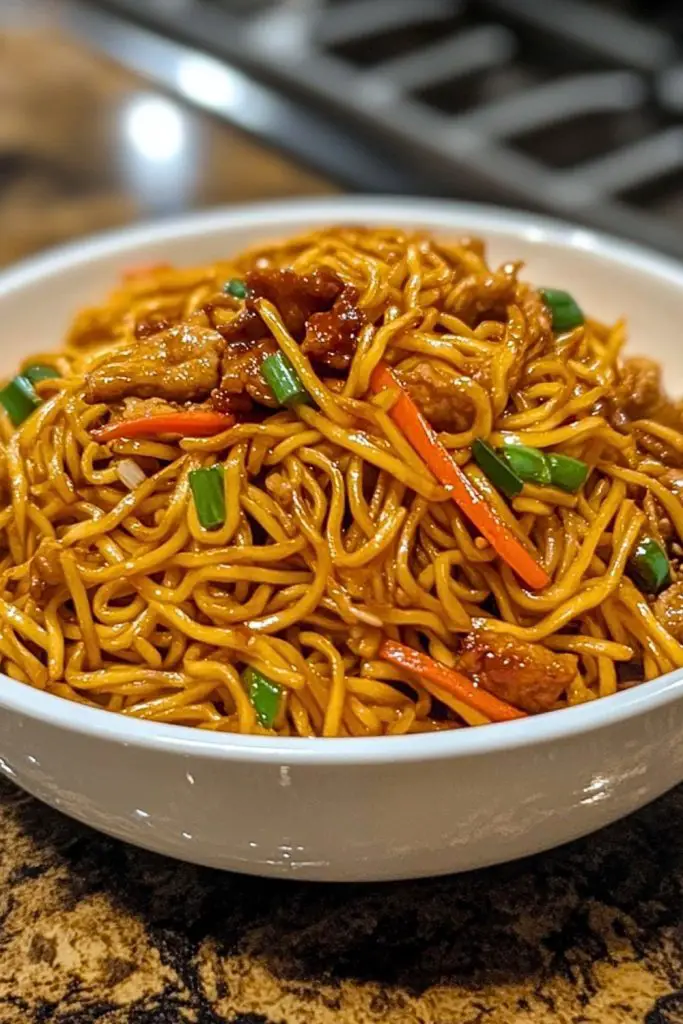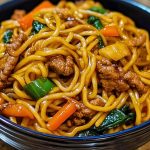I’ve always had a soft spot for fast, satisfying takeout meals—and Panda Express Chow Mein has been one of my all-time cravings. That glossy, savory tangle of noodles with bits of crisp cabbage and green onion delivers a flavor bomb with every bite. The good news? You can whip up the same delicious experience right in your kitchen.

I decided to recreate this cult-favorite dish not just to satisfy a sudden craving, but because it’s surprisingly easy, inexpensive, and incredibly flexible. Once I nailed the sauce and found the right noodles, it became a weeknight staple I could prep in under 30 minutes. Whether you’re aiming for comfort food or something to impress your dinner guests, this Panda Express Chow Mein recipe delivers every time.
Why You’ll Love This Panda Express Chow Mein
You’re going to love this recipe for so many reasons. First, it’s fast—like 25-minutes-fast—from stovetop to table. It’s got the familiar taste of takeout with the comfort of home-cooked freshness. You control the oil, the salt, and the extras. Want more veggies? Add them. Craving protein? Toss in chicken or tofu.
The sauce is savory with just the right umami punch, and the noodles soak it all up beautifully without turning mushy. Plus, it’s budget-friendly and ideal for batch-cooking. This is one of those “cook once, enjoy twice” meals you’ll come back to again and again.
What Kind of Noodles Should I Use for Panda Express Chow Mein?
To get that authentic Panda Express taste and texture, you want to use yakisoba noodles. These are soft, slightly chewy wheat noodles often found in the refrigerated section of Asian grocery stores. They’re precooked, which makes this recipe even quicker.
If you can’t find yakisoba noodles, fresh lo mein noodles or even chow mein stir-fry noodles are great substitutes. The key is to choose noodles that aren’t too thin or too starchy—they should hold up well to high heat and absorb sauce without falling apart.
Avoid spaghetti or rice noodles here. They won’t give you that signature bite or the right look. And always rinse your noodles lightly after cooking if they feel sticky—this helps separate them before stir-frying.
Options for Substitutions
This chow mein is super adaptable depending on what you’ve got on hand or your dietary preferences:
- Noodles: Can’t find yakisoba? Use lo mein noodles, ramen (discard seasoning), or even thick spaghetti in a pinch.
- Cabbage: Regular green cabbage works great, but you can also use napa cabbage or even shredded Brussels sprouts.
- Celery: If celery’s not your thing, try julienned bell peppers or snow peas for a crisp bite.
- Onions: Yellow or white onions are fine if you don’t have green onions, but add them early to mellow their flavor.
- Soy Sauce: Use tamari for gluten-free or coconut aminos for a lower-sodium alternative.
- Add-ins: Feel free to toss in grilled chicken, shrimp, tofu, or mushrooms for added substance.
- Oil: Panda Express likely uses soybean oil. You can use any neutral oil like canola or vegetable oil—or even sesame oil for an extra layer of flavor.
This recipe is easy to tweak, which makes it a great go-to even when your fridge is running low.
Ingredients for This Panda Express Chow Mein
Let’s break down the core ingredients that bring this chow mein to life and why they’re essential:
- Yakisoba Noodles
These pre-cooked wheat noodles provide the chewy, springy base that defines chow mein. They hold up well to stir-frying and soak in the sauce perfectly. - Green Cabbage
Thinly sliced cabbage adds a soft crunch and slight sweetness, balancing the saltiness of the sauce. - Celery
Provides a fresh, crisp bite that contrasts beautifully with the soft noodles. - Green Onions
These are key for aroma and a touch of sharpness. They also bring a pop of color and freshness to the dish. - Soy Sauce
The heart of the chow mein sauce—it brings umami, saltiness, and that signature deep brown hue. - Oyster Sauce
Rich and slightly sweet, this deepens the flavor of the soy sauce and gives the noodles that takeout-style glaze. - Garlic
Adds a savory base layer and punches up the flavor profile in just the right way. - Brown Sugar
Just a touch brings balance to the salty ingredients and gives the sauce a round, mellow finish. - Oil (Vegetable or Canola)
Used for stir-frying and bringing all the ingredients together. Opt for something neutral so it doesn’t overpower the sauce.
With just a few pantry staples and some fresh produce, this ingredient list creates a flavorful, nostalgic dish that truly hits the spot.

Step 1: Prepare the Noodles
If you’re using refrigerated yakisoba noodles, remove them from the packaging and gently loosen them with your hands. If they’re stiff or clumped, rinse them under warm water and drain well. For dried noodles, cook according to package instructions, drain, and let them cool slightly.
Step 2: Chop the Vegetables
Thinly slice the green cabbage and celery, aiming for even strips so they cook quickly and evenly. Chop the green onions into 1-inch sections, separating the white and green parts. Mince the garlic finely so it blends seamlessly into the sauce.
Step 3: Mix the Sauce
In a small bowl, whisk together the soy sauce, oyster sauce, brown sugar, and a splash of water. This is your flavor base—savory, sweet, and rich. Set it aside so it’s ready to go once the stir-fry starts.
Step 4: Stir-Fry the Vegetables
Heat a large wok or skillet over medium-high heat. Add about 2 tablespoons of oil, then toss in the celery, cabbage, and the white parts of the green onions. Stir-fry for 3–4 minutes until they’re slightly softened but still vibrant and crisp.
Step 5: Add the Garlic
Toss in the minced garlic and stir quickly—garlic burns fast. Cook for about 30 seconds until fragrant, keeping everything in motion.
Step 6: Add the Noodles
Toss in the prepared noodles, breaking up any remaining clumps with tongs or chopsticks. Stir everything together so the noodles start to pick up some color and heat through.
Step 7: Pour in the Sauce
Drizzle the sauce evenly over the noodles and veggies. Continue tossing for another 2–3 minutes until everything is coated and the sauce begins to cling to the noodles.
Step 8: Finish and Serve
Add the green parts of the onions, give it one last toss, and turn off the heat. Serve hot, straight from the pan—or pack it into meal prep containers for later. It tastes even better the next day.
How Long to Cook Panda Express Chow Mein
The beauty of this dish is in its speed. From the moment your wok hits the heat to the final stir, it takes about 10–12 minutes total to cook. Here’s a breakdown:
- Vegetables sauté: 3–4 minutes
- Garlic & noodles: 2–3 minutes
- Sauce & final toss: 2–3 minutes
Including prep time for slicing veggies and mixing the sauce, you’re looking at a total of 25 minutes start to finish—perfect for a busy weeknight.
Tips for Perfect Panda Express Chow Mein
- Prep everything in advance: Chow mein cooks fast, so have your veggies chopped, noodles ready, and sauce mixed before you turn on the stove.
- Use high heat: A hot wok or skillet gives you that slightly caramelized texture and keeps the veggies crisp.
- Don’t overcook the noodles: They should be heated through and just start to pick up color, not get soggy.
- Add sauce gradually if needed: You can always hold back a bit and add more later if you prefer a lighter coating.
- Taste as you go: Depending on the brand of soy sauce or oyster sauce you use, saltiness can vary. Adjust as needed.
- Don’t skip the brown sugar: It balances the umami of the soy and oyster sauces and gives the dish that signature chow mein flavor.
- Use tongs for tossing: They make it easier to move the noodles around without breaking them.
- Let it sit for 30 seconds at the end: After turning off the heat, let the noodles rest in the pan for a moment to absorb any remaining sauce.
With these tips, your homemade Panda Express Chow Mein will taste just as good—if not better—than takeout.
Watch Out for These Mistakes While Cooking
Even a quick dish like chow mein has its pitfalls. Here are a few things to avoid if you want that perfect takeout-style result:
- Using the wrong noodles: Spaghetti or thin rice noodles won’t work here. You need something springy like yakisoba or lo mein.
- Skipping the sauce prep: Stir-frying moves quickly—if your sauce isn’t ready beforehand, things can overcook while you scramble.
- Overcrowding the pan: Too many ingredients in a small skillet leads to steaming, not stir-frying. Cook in batches if necessary.
- Not preheating the wok or skillet: Cold pans lead to soggy noodles and limp veggies. You want that sizzle from the start.
- Overcooking the cabbage and celery: These should retain a bit of crunch for texture. Cook just until they start to soften.
- Adding garlic too early: Garlic burns quickly. Always add it after your veggies have started to cook.
- Over-saucing: Too much liquid can turn everything mushy. You want the sauce to coat, not drown, the noodles.
- Forgetting the finish: Toss in the green tops of the onions at the end for a fresh, vibrant lift.
What to Serve With Panda Express Chow Mein?
While this chow mein is satisfying on its own, pairing it with a few extras can turn it into a full meal experience.
Orange Chicken
A sweet, tangy, crispy counterpart to the savory noodles.
Teriyaki Chicken Skewers
Grilled and glazed, they add a smoky richness that complements the noodles.
Vegetable or Pork Dumplings
Crispy-bottomed potstickers make a great side for texture and flavor contrast.
Stir-Fried Bok Choy
Lightly sautéed with garlic and sesame oil, this adds a fresh, healthy side.
Egg Rolls
Crispy, golden, and stuffed with veggies or meat—they’re a takeout classic.
Hot and Sour Soup
A tangy, warming soup helps balance out the heavier noodles.
Honey Walnut Shrimp
Creamy, sweet, and crunchy—this makes a great upscale pairing.
Bubble Tea
For something sweet and refreshing, bubble tea rounds out the meal perfectly.
Storage Instructions
Panda Express Chow Mein stores beautifully, making it ideal for meal prep or leftovers.
- Refrigerator: Store in an airtight container for up to 4 days. The flavors actually deepen overnight, making next-day leftovers even tastier.
- Freezer: While technically possible, freezing can alter the texture of the noodles and vegetables. If you must freeze it, use a freezer-safe container and consume within 1 month. Reheat directly from frozen or thaw overnight in the fridge.
- Reheating: Warm in a skillet over medium heat with a splash of water or soy sauce to loosen the noodles. Alternatively, microwave in 30-second bursts, stirring in between, until heated through.
Tip: Avoid storing in the same container as any crispy sides like egg rolls—they’ll lose their crunch.
Estimated Nutrition
Keep in mind these are approximations based on a standard serving (~1.5 cups), using traditional ingredients without added proteins:
- Calories: 380 kcal
- Protein: 9g
- Fat: 13g
- Carbohydrates: 55g
- Sugar: 5g
- Fiber: 3g
- Sodium: 850mg (varies by sauce brands used)
- Cholesterol: 0mg (without meat or egg)
Adding chicken, tofu, or shrimp will adjust these values. To lower sodium, opt for low-sodium soy sauce or skip the oyster sauce and use a lighter alternative.
Frequently Asked Questions
Can I use regular spaghetti instead of yakisoba noodles?
You can, but it won’t have the same chewy texture or authentic flavor. If you do use spaghetti, cook it al dente and rinse to remove excess starch before stir-frying.
Is Panda Express Chow Mein vegetarian?
This version can be! Just ensure your oyster sauce is vegetarian (or replace it with mushroom stir-fry sauce), and skip any meat add-ins.
How can I make this gluten-free?
Use gluten-free tamari instead of soy sauce and look for rice noodles or gluten-free yakisoba alternatives. Be sure your oyster sauce or substitute is also gluten-free.
Can I add protein to the recipe?
Absolutely. Stir-fried chicken, tofu, shrimp, or even beef strips work great. Cook them first, set aside, and toss back in when adding the sauce.
How do I prevent my noodles from clumping?
Rinse and drain them well before cooking, especially if using pre-packaged yakisoba. A splash of oil and frequent tossing while cooking also help.
What kind of oil should I use?
Use a neutral oil like vegetable, canola, or sunflower oil. For extra flavor, you can finish with a drizzle of toasted sesame oil at the end.
Can I make it spicy?
Yes! Add a dash of sriracha, chili garlic sauce, or toss in crushed red pepper flakes during the sauce step for a spicy kick.
Is this good for meal prep?
Definitely. It keeps well in the fridge for several days, reheats beautifully, and can be portioned out with proteins or veggies for balanced meals.
Conclusion
Making Panda Express Chow Mein at home is one of those game-changing kitchen wins. It’s fast, budget-friendly, and tastes just like the real deal—maybe better. Whether you’re recreating a favorite takeout night or just want something savory and satisfying in under 30 minutes, this chow mein hits the mark every time.
It’s also a flexible base: add your favorite protein, toss in extra veggies, or go full comfort-food mode. Once you try it, you’ll wonder why you didn’t make it sooner. Trust me—this one’s going in your regular rotation.

Panda Express Chow Mein Recipe
- Total Time: 22 minutes
- Yield: 3-4 servings
Description
Bring your favorite takeout home with this irresistible Panda Express Chow Mein copycat recipe. Perfectly stir-fried yakisoba noodles tossed with savory soy-oyster sauce, fresh cabbage, crisp celery, and green onions create a dish that’s bursting with flavor. This easy recipe is ideal for quick dinners, weekday meal prep, or a comforting snack. With just 25 minutes from prep to plate, it’s one of those easy dinner ideas that tastes like it took hours. Whether you’re after a quick breakfast-for-dinner or simple food ideas that satisfy, this chow mein is sure to hit the spot.
Ingredients
- 14 oz yakisoba noodles (pre-cooked)
- 2 cups green cabbage, thinly sliced
- 2 celery stalks, thinly sliced
- 4 green onions, chopped (white and green parts separated)
- 2 garlic cloves, minced
- 2 tablespoons soy sauce
- 1 tablespoon oyster sauce
- 1 teaspoon brown sugar
- 2 tablespoons vegetable or canola oil
- Splash of water (to thin sauce if needed)
Instructions
- Loosen or rinse yakisoba noodles and set aside.
- Thinly slice cabbage, celery, and chop green onions.
- In a small bowl, mix soy sauce, oyster sauce, brown sugar, and a splash of water. Set aside.
- Heat oil in a large wok or skillet over medium-high heat.
- Add cabbage, celery, and white parts of green onions. Stir-fry for 3–4 minutes.
- Add garlic and cook for 30 seconds until fragrant.
- Add noodles and toss to combine.
- Pour in the sauce and stir-fry for 2–3 more minutes until well-coated.
- Add green parts of onions, toss, and remove from heat.
- Serve hot and enjoy!
- Prep Time: 10 minutes
- Cook Time: 12 minutes

